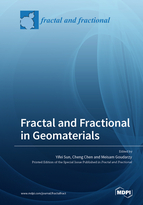Fractal and Fractional in Geomaterials
A special issue of Fractal and Fractional (ISSN 2504-3110). This special issue belongs to the section "Engineering".
Deadline for manuscript submissions: closed (30 March 2022) | Viewed by 34337
Special Issue Editors
Interests: fractional plasticity; fractional viscoelasticity; fractals in particle breakage; geomechanics; heat conduction
Special Issues, Collections and Topics in MDPI journals
Interests: micromechanics; microstructure; geomaterials; discrete element methods
Interests: particle breakage; micromechanics; granular soils; peats; geomaterials; discrete element methods; soil dynamic; seismic ground response; earthquake; ground vibration
Special Issue Information
Dear colleagues,
Geomaterial is one of the most common materials in the world. Based on its function, there can be different types of geomaterials, e.g., soft soils, granular aggregates, and composite material. However, no matter what kind of geomaterials are used, fractal laws can be observed in material responses. For example, the pore size or contact force network within granular aggregates can obey fractal distribution, which can be described using fractional calculus or other advanced mathematical tools. In recent years, the application of fractal theory and fractional mechanics in characterizing the micro-to-macro behavior of geomaterials has attracted worldwide attention.
The aim of this Special Issue is to present state-of-the-art research outcomes in fractal or fractional approaches for geomaterials. Therefore, high-quality review papers, full-length research articles, and technical notes from different disciplines are cordially welcome. Research topics include but are not limited to the following aspects:
- Fractal laws for contact networks/pore structures in geomaterial;
- Fractional mechanics modelling of geomaterial;
- Local/nonlocal deformation in geomaterial;
- Non-Fourier/non-Fickian/non-Darcy law for geomaterial.
- Other nonconventional approaches for geomaterials.
Dr. Yifei Sun
Dr. Cheng Chen
Dr. Meisam Goudarzy
Guest Editors
Manuscript Submission Information
Manuscripts should be submitted online at www.mdpi.com by registering and logging in to this website. Once you are registered, click here to go to the submission form. Manuscripts can be submitted until the deadline. All submissions that pass pre-check are peer-reviewed. Accepted papers will be published continuously in the journal (as soon as accepted) and will be listed together on the special issue website. Research articles, review articles as well as short communications are invited. For planned papers, a title and short abstract (about 100 words) can be sent to the Editorial Office for announcement on this website.
Submitted manuscripts should not have been published previously, nor be under consideration for publication elsewhere (except conference proceedings papers). All manuscripts are thoroughly refereed through a single-blind peer-review process. A guide for authors and other relevant information for submission of manuscripts is available on the Instructions for Authors page. Fractal and Fractional is an international peer-reviewed open access monthly journal published by MDPI.
Please visit the Instructions for Authors page before submitting a manuscript. The Article Processing Charge (APC) for publication in this open access journal is 2700 CHF (Swiss Francs). Submitted papers should be well formatted and use good English. Authors may use MDPI's English editing service prior to publication or during author revisions.
Keywords
- fractal media
- fractional mechanics
- Micro-to-Macro
- geomaterial
- nonconventional approach








